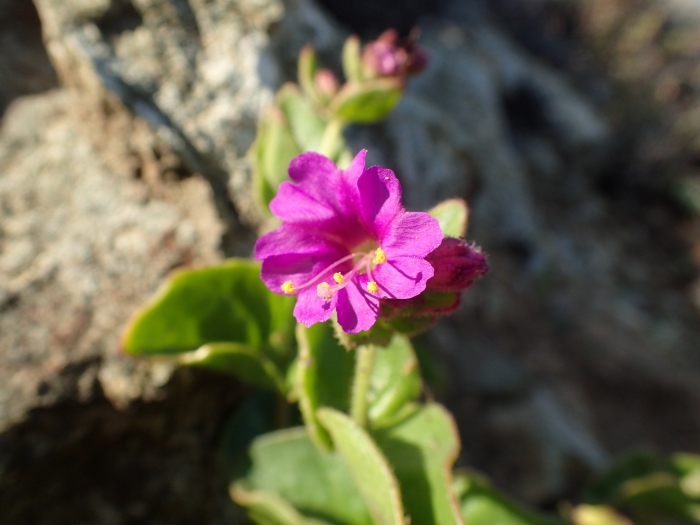California Four O’Clock
(Mirabilis laevis var. crassifolia)
California Four O’Clock (Mirabilis laevis var. crassifolia)
/
/

Scott Yarger
Public Domain
Image By:
Scott Yarger
Recorded By:
Copyright:
Public Domain
Copyright Notice:
Photo by: Scott Yarger | License Type: Public Domain | License URL: http://creativecommons.org/publicdomain/zero/1.0/ | Rights Holder: Scott Yarger | Publisher: iNaturalist | Date Created: 2020-02-29T16:40:48-08:00 |





















































Estimated Native Range
Summary
Mirabilis laevis var. crassifolia, commonly known as California Four O’Clock, is a deciduous subshrub native to the chaparral, desert scrub, and grasslands of California, extending into Northwest Mexico. It typically grows to a height of 2 feet (0.6 meters) and spreads to about 4 feet (1.2 meters). This plant forms a mound of thick, succulent stems and heart-shaped leaves, with a profusion of trumpet-shaped flowers that are most commonly magenta but can also be pink or white. The flowers open in the late afternoon and evening, hence the common name. Flowering occurs from late spring through summer and into fall, providing a long season of interest.
California Four O’Clock is valued for its drought tolerance and its ability to thrive in challenging environments, making it an excellent choice for xeriscaping and water-wise gardens. It is also used in native plant gardens, as ground cover, and in naturalized areas. It requires minimal maintenance once established, needing only occasional water in extreme drought. It prefers well-drained soils and can handle a range of soil types, from sandy to loamy. While it does best in full sun, it can also tolerate part shade. There are no major disease or pest issues, but it can self-seed prolifically, which may be considered a problem in some settings. It is not known to have aggressive roots or to be invasive when grown outside its native range.CC BY-SA 4.0
California Four O’Clock is valued for its drought tolerance and its ability to thrive in challenging environments, making it an excellent choice for xeriscaping and water-wise gardens. It is also used in native plant gardens, as ground cover, and in naturalized areas. It requires minimal maintenance once established, needing only occasional water in extreme drought. It prefers well-drained soils and can handle a range of soil types, from sandy to loamy. While it does best in full sun, it can also tolerate part shade. There are no major disease or pest issues, but it can self-seed prolifically, which may be considered a problem in some settings. It is not known to have aggressive roots or to be invasive when grown outside its native range.CC BY-SA 4.0
Plant Description
- Plant Type: Subshrub
- Height: 1-3 feet
- Width: 1-4 feet
- Growth Rate: Moderate
- Flower Color: Pink, Purple
- Flowering Season: Spring, Summer
- Leaf Retention: Deciduous
Growth Requirements
- Sun: Full Sun, Part Shade
- Water: Low
- Drainage: Slow, Medium, Fast
Common Uses
Bee Garden, Bird Garden, Butterfly Garden, Deer Resistant, Fragrant, Groundcover, Hummingbird Garden, Low Maintenance, Rabbit Resistant, Showy Flowers
Natural Habitat
Native to chaparral, desert scrub, and grasslands of California and Northwest Mexico
Other Names
Common Names:
Scientific Names: , Mirabilis laevis var. crassifolia, Mirabilis californica, Mirabilis californica var. californica, Oxybaphus californicus, Mirabilis californica var. cedrosensis, Mirabilis laevis var. cedrosensis, Hesperonia californica, Hesperonia cedrosensis, Hesperonia heimerlii
GBIF Accepted Name: Mirabilis laevis var. crassifolia (Choisy) Spellenb.